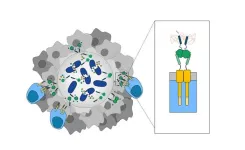(Press-News.org) Two million years ago, Homo erectus had expanded beyond the lowland savanna environments of East Africa and into the high-altitude regions of the Ethiopian highlands, where they produced both Oldowan and Acheulean tools, according to a new study. It presents a reanalysis of an early hominin fossil first discovered in 1981. The findings provide novel insights into the evolution, migration and adaptive capacities of early human ancestors. In Africa, the limited number of hominin fossils found in direct association with stone tools has hindered attempts to link Homo habilis and Homo erectus with particular stone tool industries, namely Oldowan or Acheulean. One region critical to studying this question is a collection of sites known as the Melka Kunture complex – a cluster of prehistoric sites on the highlands of Ethiopia at an altitude of ~2000 meters above sea level. In 1981, a fossilized infant mandible was discovered at the Garba IV site and in direct association with Oldowan lithic tools. However, the hominin species the fossil represents has been the subject of debate. In this study, Margherita Mussi and colleagues evaluate the geochronological context of the Garba IV site and re-assess the taxonomic affinity of the fossil mandible. Using synchrotron imaging to examine the internal morphology of the unerupted teeth in the Garba IV mandible, Mussi et al. confirm that it belonged to H. erectus. Moreover, combining preliminary argon-argon dates for the site’s stratigraphy with a more recently published magnetostratigraphic analysis, the authors argue that the fossil is around 2 million years old, making it one of the earliest H. erectus specimens yet discovered and the only one in clear association with an abundant Oldowan lithic industry. The overlying Acheulean tool-bearing strata, which date to ~1.95 million years ago, represent the earliest known evidence of Acheulean lithic technology. According to Mussi et al., the findings demonstrate that by 2 million years ago, H. erectus adapted early and quickly to a high-altitude mountain environment, first producing Oldowan technology and then Acheulean technology.
END
About 2 million years ago, Homo Erectus lived at high altitudes and produced both Oldowan and Acheulean tools
2023-10-12
ELSE PRESS RELEASES FROM THIS DATE:
Engineered bacteria guide CAR-T cells to poorly infiltrated solid tumors
2023-10-12
A new probiotic-guided chimeric antigen receptor (CAR)-T platform uses engineered bacteria to infiltrate and produce synthetic antigen targets, enabling CAR-T cells to find, identify, and destroy tumor cells in situ, according to a new study. The combined cell therapy platform expands the scope of CAR-T cell therapy to include difficult-to-target solid tumors. Immunotherapies using CAR-T cells have proven successful in treating some types of blood cancers. However, their efficacy against solid tumors remains elusive. A key challenge facing tumor-antigen targeting immunotherapies like CAR-T is the identification of suitable ...
An electrical switch to control chemical reactions
2023-10-12
New pharmaceuticals, cleaner fuels, biodegradable plastics: in order to meet society’s needs, chemists have to develop new synthesis methods to obtain new products that do not exist in their natural state. A research group at the University of Geneva (UNIGE), in collaboration with Cardiff University, has discovered how to use an external electric field to control and accelerate a chemical reaction, like a ‘‘switch’’. This work, to be read in Science Advances, could have a considerable impact on the development of new molecules, enabling not only more environmentally friendly synthesis, but also very simple external control of a chemical reaction.
In ...
Gray whales experience major population swings as a result of Arctic conditions, research shows
2023-10-12
NEWPORT, Ore. – Dynamic and changing Arctic Ocean conditions likely caused three major mortality events in the eastern North Pacific gray whale population since the 1980s, a new study has found.
During each of these die-offs, including one that began in 2019 and is ongoing, the gray whale population was reduced by up to 25% over just a few years, said Joshua Stewart, an assistant professor with Oregon State University’s Marine Mammal Institute and the study’s lead author.
“These are extreme population swings that we did not expect to see in a large, long-lived species like gray whales,” Stewart said. “When the availability ...
Cell atlases of the human brain presented in Science
2023-10-12
In two parallel projects, researchers at Karolinska Institutet have been involved in creating the most comprehensive atlases of human brain cells to date. The two studies, which are published in Science, provide clues on different brain diseases and give hope for medical advancements in the future, such as new cancer drugs.
Knowing what cells constitute the healthy brain, where different cell types are located and how the brain develops from the embryo stage is fundamental to the ability to compare and better understand how diseases arise. There are at present advanced atlases of the ...
Coffee and cocoa plants at risk from pollinator loss
2023-10-12
Tropical crops such as coffee, cocoa, watermelon and mango may be at risk due to the loss of insect pollinators, finds a new study led by UCL and Natural History Museum researchers.
Published in Science Advances, the study explores the intricate interplay between climate change, land use change, and their impact on pollinator biodiversity, ultimately revealing significant implications for global crop pollination.
The study, which compiled data from 1,507 crop growing sites around the world and catalogued 3,080 insect pollinator species, exposes a concerning trend – the combined pressures ...
Scientists unveil detailed cell maps of the human brain and the nonhuman primate brain
2023-10-12
A group of international scientists have mapped the genetic, cellular, and structural makeup of the human brain and the nonhuman primate brain. This understanding of brain structure, achieved by funding through the National Institutes of Health’s Brain Research Through Advancing Innovative Neurotechnologies® Initiative, or The BRAIN Initiative®, allows for a deeper knowledge of the cellular basis of brain function and dysfunction, helping pave the way for a new generation of precision therapeutics for people with mental disorders and other disorders of the brain. The findings appear in a compendium of ...
Engineered bacteria paint targets on tumors for cancer-killing T cells to see
2023-10-12
New York, NY—October 12, 2023—For several years, researchers have been successfully using chimeric antigen receptor (CAR) T cells to target specific antigens found on blood cells as a cure for patients with leukemia and lymphoma. But solid tumors, like breast and colon cancers, have proven to be more difficult to home in on. Solid tumors contain a mix of cells that display different antigens on their surface-often shared with healthy cells in the body. Thus, identifying a consistent and safe target has impeded the success of most CAR-T cell therapy for solid tumors at the first phase ...
How do tax proposals affect cancer health of tobacco users based on income, education?
2023-10-12
Tobacco is the leading cause of preventable death in the United States, according to the Centers for Disease Control and Prevention, and cigarette smoking causes three in 10 of all cancer deaths. Smoking also accounts for more than 30 percent of the difference in life expectancy among different socioeconomic groups.
Roberta Freitas-Lemos, research assistant professor at the Fralin Biomedical Research Institute at VTC, recently received a career development award to explore the ways in which nicotine tax policies can influence health disparities. The award of more than $680,000 over five years from the National Cancer Institute of the National Institutes of Health is designed ...
NIH awards Mount Sinai researchers $12 million to personalize sickle cell treatment
2023-10-12
New York, NY (October 12, 2023) - The Mount Sinai Health System has received a $12,180,625 grant from the National Heart, Lung and Blood Institute to compare new treatment options for sickle cell disease and determine which work best for specific patients.
“Sickle cell traditionally has been a neglected disease, but it benefited from a flurry of innovation over the last decade and there are now three new medications approved for the disease,” says Jeffrey Glassberg, MD, Director of the Mount Sinai Sickle Cell Program.
“While this is welcome news, clinicians now have a new challenge. ...
Caution: Content warnings do not reduce stress, study shows
2023-10-12
Advocates for the use of trigger warnings suggest that they can help people avoid or emotionally prepare for encountering content related to a past trauma. But trigger warnings may not fulfill either of these functions, according to an analysis published in Clinical Psychological Science, a journal of the Association for Psychological Science.
Instead, warnings appear to heighten the anticipatory anxiety a person may feel prior to viewing sensitive material while making them no less likely to consume that content, wrote Victoria M. E. Bridgland of ...



